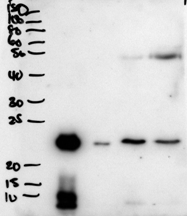BPIFA1 / PLUNC Antibody (C-Term)
Peptide-affinity purified goat antibody
- SPECIFICATION
- CITATIONS
- PROTOCOLS
- BACKGROUND

Application
| WB, E |
|---|---|
| Primary Accession | Q9NP55 |
| Other Accession | NP_057667.1, 51297 |
| Reactivity | Human |
| Host | Goat |
| Clonality | Polyclonal |
| Concentration | 0.5 mg/ml |
| Isotype | IgG |
| Calculated MW | 26713 Da |
| Gene ID | 51297 |
|---|---|
| Other Names | BPI fold-containing family A member 1, Lung-specific protein X, Nasopharyngeal carcinoma-related protein, Palate lung and nasal epithelium clone protein, Secretory protein in upper respiratory tracts, Short PLUNC1, SPLUNC1, Tracheal epithelium-enriched protein, Von Ebner protein Hl, BPIFA1, LUNX, NASG, PLUNC, SPLUNC1, SPURT |
| Format | 0.5 mg/ml in Tris saline, 0.02% sodium azide, pH7.3 with 0.5% bovine serum albumin |
| Storage | Maintain refrigerated at 2-8°C for up to 6 months. For long term storage store at -20°C in small aliquots to prevent freeze-thaw cycles. |
| Precautions | BPIFA1 / PLUNC Antibody (C-Term) is for research use only and not for use in diagnostic or therapeutic procedures. |
| Name | BPIFA1 |
|---|---|
| Synonyms | LUNX, NASG, PLUNC, SPLUNC1, SPURT |
| Function | Lipid-binding protein which shows high specificity for the surfactant phospholipid dipalmitoylphosphatidylcholine (DPPC) (PubMed:25223608). Plays a role in the innate immune responses of the upper airways (PubMed:23499554, PubMed:23132494). Reduces the surface tension in secretions from airway epithelia and inhibits the formation of biofilm by pathogenic Gram-negative bacteria, such as P.aeruginosa and K.pneumoniae (PubMed:23499554, PubMed:23132494, PubMed:27145151). Negatively regulates proteolytic cleavage of SCNN1G, an event that is required for activation of the epithelial sodium channel (ENaC), and thereby contributes to airway surface liquid homeostasis and proper clearance of mucus (PubMed:24124190, PubMed:24043776). Plays a role in the airway inflammatory response after exposure to irritants (PubMed:11425234). May attract macrophages and neutrophils (PubMed:23132494). |
| Cellular Location | Secreted. Note=Apical side of airway epithelial cells. Detected in airway surface liquid, nasal mucus and sputum |
| Tissue Location | Highly expressed in lung, upper airways and nasopharyngeal regions, including trachea and nasal epithelium (at protein level) (PubMed:11018263, PubMed:11251963, PubMed:12409287, PubMed:11425234, PubMed:26559477). Specifically expressed in the secretory ducts and submucosal glands of tracheobronchial tissues (at protein level) (PubMed:12409287, PubMed:11425234). Also expressed in the eye where it is detected in lacrimal gland, eyelid, conjunctiva and cornea (at protein level) (PubMed:26559477). Specifically localizes to epithelial cell layers in cornea, eyelid (basal epithelium) and conjunctiva (at protein level) (PubMed:26559477). Detected within acinar cells and ducts in the lacrimal and Meibomian glands (at protein level) (PubMed:26559477). In lung, shows highest expression in the trachea and progressive decrease from proximal (bronchial) to distal (bronchiolar) airways (PubMed:12409287). Also expressed in lung cancers and some other types of cancer (PubMed:11251963) |

Thousands of laboratories across the world have published research that depended on the performance of antibodies from Abcepta to advance their research. Check out links to articles that cite our products in major peer-reviewed journals, organized by research category.
info@abcepta.com, and receive a free "I Love Antibodies" mug.
Provided below are standard protocols that you may find useful for product applications.
Background
Reported variants represent identical protein: NP_057667.1, NP_001230122.1, NP_570913.1
References
Antimicrobial activity of PLUNC protects against Pseudomonas aeruginosa infection. Lukinskiene L, Liu Y, Reynolds SD, Steele C, Stripp BR, Leikauf GD, Kolls JK, Di YP. J Immunol. 2011 Jul 1;187(1):382-90. PMID: 21632717
If you have used an Abcepta product and would like to share how it has performed, please click on the "Submit Review" button and provide the requested information. Our staff will examine and post your review and contact you if needed.
If you have any additional inquiries please email technical services at tech@abcepta.com.













 Foundational characteristics of cancer include proliferation, angiogenesis, migration, evasion of apoptosis, and cellular immortality. Find key markers for these cellular processes and antibodies to detect them.
Foundational characteristics of cancer include proliferation, angiogenesis, migration, evasion of apoptosis, and cellular immortality. Find key markers for these cellular processes and antibodies to detect them. The SUMOplot™ Analysis Program predicts and scores sumoylation sites in your protein. SUMOylation is a post-translational modification involved in various cellular processes, such as nuclear-cytosolic transport, transcriptional regulation, apoptosis, protein stability, response to stress, and progression through the cell cycle.
The SUMOplot™ Analysis Program predicts and scores sumoylation sites in your protein. SUMOylation is a post-translational modification involved in various cellular processes, such as nuclear-cytosolic transport, transcriptional regulation, apoptosis, protein stability, response to stress, and progression through the cell cycle. The Autophagy Receptor Motif Plotter predicts and scores autophagy receptor binding sites in your protein. Identifying proteins connected to this pathway is critical to understanding the role of autophagy in physiological as well as pathological processes such as development, differentiation, neurodegenerative diseases, stress, infection, and cancer.
The Autophagy Receptor Motif Plotter predicts and scores autophagy receptor binding sites in your protein. Identifying proteins connected to this pathway is critical to understanding the role of autophagy in physiological as well as pathological processes such as development, differentiation, neurodegenerative diseases, stress, infection, and cancer.


